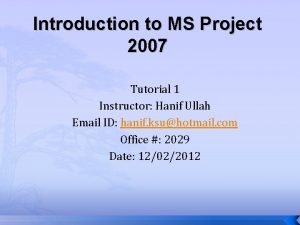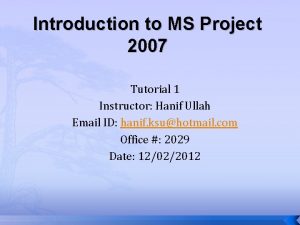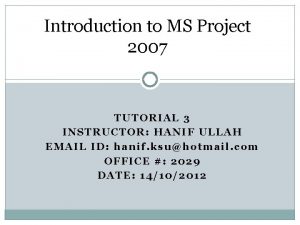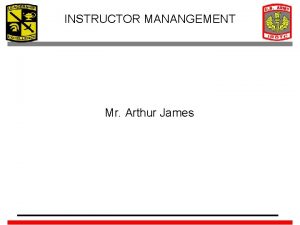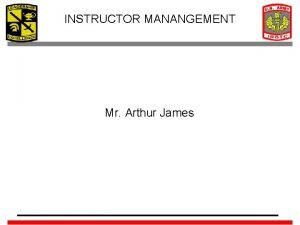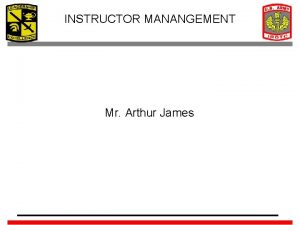Introduction to MS Project 2007 TUTORIAL 8 INSTRUCTOR














- Slides: 14

Introduction to MS Project 2007 TUTORIAL 8 INSTRUCTOR: HANIF ULLAH EMAIL ID: hanif. ksu@hotmail. com OFFICE #: 2029 DATE: 15/04/2012

Examining Resource Allocations over Time 2 �In this exercise, you will focus on resource allocation- how the task assignments you’ve made affect the workloads of the work resources (people and equipment) of a project. The relationship between a resource’s capacity and his or her task assignments is called allocation. Each work resource is in one of three states of allocation: �Underallocated The resource’s assignments do not fill the resource’s maximum capacity. For example, a fulltime resource who has only 25 hours of work assigned in a 40 -hour work week is underallocated.

Examining Resource Allocations over Time 3 �Fully allocated The resource’s assignments fill the resource’s maximum capacity. For example, a fulltime resource who has 40 hours of work assigned in a 40 -hour work week is fully allocated. �Overallocated The resource’s assignments exceed the resource’s maximum capacity. For example, a fulltime resource who has 65 hours of work assigned in a 40 -hour work week is overallocated �In this exercise, you look at resource allocations and focus on two resources who are overallocated.

Examining Resource Allocations over Time 4 �On the View menu, click More Views, click Resource Allocation, and then click the Apply button. �The Resource Allocation view appears. This is a split view, with the Resource Usage view on top and the Leveling Gantt Chart view on the bottom. �On the left side of the Resource Usage view is a table (the Usage table, by default) that shows assignments grouped per resource, the total work assigned to each resource, and each assignment’s work. �The right side of the view contains assignment details (work, by default) arranged on a timescale. �The bottom pane shows the Leveling Gantt Chart view only for whatever resource or assignment (single or multiple) is selected in the upper pane.

Examining Resource Allocations over Time 5 � On the Standard toolbar, click the Scroll To Task button � Click the Resource Name column heading. � On the Project menu, point to Outline and then click Hide Assignments � Next, you will look at two work resources and their allocations. � 7. In the Resource Name column, click the name of resource 4. � 8. On the Standard toolbar, click Scroll To Task. � Point to the W column heading (for Wednesday) at the top of the timescaled grid. � A Screen. Tip appears with the date of the assignment: � On the Format menu, click Timescale. � Make sure that the Middle Tier tab is selected, and in the Units box under Middle tier formatting, click Months. � In the Show box under Timescale options, click One tier (Middle). Click OK to close the Timescale dialog box.

Manually Resolving Resource Overallocations 6 �In this exercise, you will manually edit an assignment to resolve a resource overallocation. �In the Resource Usage view in the upper pane, scroll vertically through the Resource Name column �Note that several names appear in red. These are overallocated resources. �In the Resource Name column, click the plus sign next to the name of resource 4, to display his assignments �On the Standard toolbar, click Scroll To Task �In the upper pane, you see that resource 4 is assigned fulltime to two tasks that both start same time. He is overallocated for the duration of both tasks.

Manually Resolving Resource Overallocations 7 � Next, you will manually resolve this overallocation by reducing the assignment units value. � In the Resource Name column, click Developer’s first assignment � On the Standard toolbar, click the Assignment Information button. � Click the General tab if it is not already visible � In the Units box, type or click 50%, and then click OK to close the Assignment Information dialog box. � Click the Smart Tag Actions button � On the Smart Tag Actions list, click Change the task’s total work (person-hours) to match the units and duration. � Project reduces Developer’s work assignments on the task and restores the task to its original duration.

Manually Resolving Resource Overallocations 8 � However, Developer is still overallocated. To remedy this, you will reduce his assignment units on the second task. � In the Resource Name column, click Developer’s second assignment. � On the Standard toolbar, click Assignment Information. � The Assignment Information dialog box appears. � Click the General tab if it is not already visible. � In the Units box, type or click 50%, and then click OK to close the Assignment Information dialog box. � Click Smart Tag Actions. � On the Smart Tag Actions list, click Change the task’s total work (person-hours) to match the units and duration.

Leveling Overallocated Resources 9 � In this exercise, you level resources and view the effects on assignments and the project finish date. � 1. On the Window menu, click Remove Split. � 2. On the View menu, click Resource Sheet. � On the Tools menu, click Level Resources � Under Leveling calculations, make sure that Manual is selected � In the Look for overallocations on a…basis box, make sure that Day by Day is selected. � Make sure that the Clear leveling values before leveling check box is selected. � Under Leveling range for ‘Software Development’, make sure that Level entire project is selected. � In the Leveling order box, make sure that Standard is selected. � Make sure that the Level only within available slack check box is cleared. � Make sure that the Leveling can adjust individual assignments on a task check box is selected.

Leveling Overallocated Resources 10 � Make sure that the Leveling can create splits in remaining work check box is selected. � Click the Level Now button. � Project asks whether you want to level the entire pool or only selected resources. Leave Entire Pool selected, and click OK. � Project levels the overallocated resources. � Next, you will look at the project plan before and after leveling by using the Leveling Gantt view. � On the View menu, click More Views, click Leveling Gantt, and then click Apply. � Project switches to the Leveling Gantt view. � Click the name of any task � On the Standard toolbar, click Scroll To Task � This view gives you a better look at some of the tasks that were affected by leveling.

Examining Project Costs 11 �The types of costs you might encounter over the life of a project include the following: �Baseline costs The original planned task, resource, or assignment costs saved as part of a baseline plan. �Current (or scheduled) costs The calculated costs of tasks, resources, and assignments in a project plan. �Actual costs The costs that have been incurred for tasks, resources, or assignments. �Remaining costs The difference between the current or scheduled costs and the actual costs for tasks, resources, or assignments.

Examining Project Costs 12 �In this exercise, you look at the overall project costs and at individual task costs. �On the View menu, click More Views, click Task Sheet, and then click Apply. �On the Tools menu, click Options. �In the Options dialog box, click the View tab if it is not already visible. �Under the Outline options for label, select the Show project summary task check box, and then click OK. �On the View menu, point to Table: Entry, and click Cost. �The Cost table appears. � 6. If necessary, double-click the right edge of a column in the column heading to expand the column so that you can see the entire value.

Checking the Project’s Finish Date 13 � In this exercise, you look at the project’s finish date and critical path. � 1. On the Project menu, click Project Information. � The Project Information dialog box appears. � Next, you will look at the duration values for this project. � In the Project Information dialog box, click the Statistics button. � The Project Statistics dialog box appears. � Here you can see the project’s current, baseline, and actual start and finish dates, as well as its schedule variance. � Click Close to close the Project Statistics dialog box. To conclude this exercise, you will look at the critical path. � On the View menu, click More Views, click Detail Gantt, and then click Apply. � The Detail Gantt view replaces the Task Sheet view. � On the Edit menu, click Go To. � In the ID box, type any number, and then click OK. � Project scrolls the view to show that specific task.

14 END of Tutorial 8
 Ms project 2007 training
Ms project 2007 training Microsoft project 2007 tutorial
Microsoft project 2007 tutorial Ms project 2007
Ms project 2007 Ms office project 2007
Ms office project 2007 Ms project poprzedniki
Ms project poprzedniki Ms word 2007 introduction
Ms word 2007 introduction Participante contreras
Participante contreras Basic instructor course texas
Basic instructor course texas Basic instructor course texas
Basic instructor course texas Basic instructor course tcole
Basic instructor course tcole Pepperball hotshot
Pepperball hotshot Not only the students but also the instructor
Not only the students but also the instructor Instructor vs teacher
Instructor vs teacher Cisco certified instructor
Cisco certified instructor Mptc firearms
Mptc firearms

